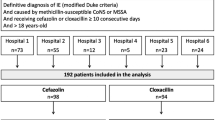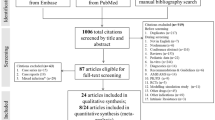Summary
During a six-year period 23 patients with isolation ofCorynebacterium jeikeium (formerly known asCorynebacterium group JK) from one or more blood cultures at a university hospital were identified. Cases occurred sporadically without time- or ward-related clustering. Review of the cases showed that most infections were nosocomial, that most of the patients had underlying malignant disease, had a chronic intravascular catheter implanted, had been pretreated with antibiotics, and were neutropenic at the time the blood cultures were drawn. Patients with only one versus those with more than one positive blood culture differed in some important aspects. Patients with only one positive blood culture were less likely to have acute leukemia, had significantly higher neutrophil counts and a shorter duration of preceding antibiotic treatment, and all had other probable causes of infection and fever. The mortality also appeared to be lower in these patients. Despite the possibility of increasing frequency of blood cultures positive forC. jeikeium, severe infections due to this organism continue to be largely confined to neutropenic patients with hematologic malignancy.
Zusammenfassung
In einer Universitätsklinik wurde während eines Zeitraumes von sechs Jahren bei 23 PatientenCorynebacterium jeikeium aus Blutkulturen isoliert.C. jeikeium-Bakteriämien traten weder zeitlich noch örtlich gehäuft auf. Die retrospektive Analyse der Patientendaten zeigte, daß in den meisten Fällen eine maligne hämatologische Grunderkrankung mit Neutropenie vorlag, ein zentral-venöser Katheter implantiert und eine antibiotische Therapie vorausgegangen war. Die Patientenpopulation mit nur einer positiven Blutkultur unterschied sich in wichtigen Aspekten von derjenigen mit mehreren positiven Blutkulturen. So waren Patienten mit nur einer positiven Blutkultur seltener an akuter Leukämie erkrankt, hatten signifikant höhere neutrophile Granulozytenkonzentrationen im peripheren Blut und waren zuvor über einen kürzeren Zeitraum antibiotisch behandelt worden. Weiterhin fanden sich in dieser Patientengruppe in allen Fällen andere mögliche Ursachen der Fieberepisoden. Auch die Mortalität war deutlich geringer. Trotz des zunehmend häufigeren Nachweises vonCorynebacterium jeikeium in Blutkulturen bleiben schwere Infektionen durch diesen Erreger weiterhin meist auf die Patientenpopulation mit hämatologischer Grunderkrankung und Neutropenie beschränkt.
Similar content being viewed by others
References
Downie, G. W., Gill, D. S. Infection in an immunocompromised patient caused by group JKCorynebacterium. J. Infect. 8 (1984) 262–263.
Dibb, W. L., von der Lippe, E. Septicemia in granulocytic patients caused by multiresistant diphtheroid rods. Acta Pathol. Microbiol. Scand. (B) 92 (1984) 181–182.
Hoffmann, S., Ersgaard, H., Justesen, T., Friis, H. Fatal meningitis with group JK Corynebacteria in a leucopenic patient. Eur. J. Clin. Microbiol. 2 (1983) 213–215.
Gill, V. J., Manning, C., Lamson, M., Woltering, P., Pizzo, P. A. Antibiotic-resistant group JK bacteria in hospitals. J. Clin. Microbiol. 13 (1981) 472–477.
Hande, K. R., Witebsky, F. G., Brown, M. S. Sepsis with a new species ofCorynebacterium. Ann. Int. Med. 85 (1976) 423–426.
Riley, P. S., Hollis, D. G., Utter, G. B., Weaver, R. E., Baker, C. N. Characterization and identification of 95 diphtheroid (group JK) cultures isolated from clinical specimens. J. Clin. Microbiol. 9 (1979) 418–424.
Stamm, W. E., Tompkins, L. S., Wagner, K. F., Counts, G. W., Thomas, E. D., Meyers, J. D. Infection due toCorynebacterium species in marrow transplant patients. Ann. Intern. Med. 91 (1979) 167–173.
Murray, B. E., Karchmer, A. W., Moellering, R. C. Jr. Diphtheroid prosthetic valve endocarditis: a study of clinical features and infecting organisms. Am. J. Med. 69 (1980) 838–848.
Van Scoy, R. E., Cohen, S. N., Geraci, J. E., Washington II, J. A. Corynebacterial endocarditis: Difficulties in diagnosis and treatment, presentation of three cases, and review of the literature. Mayo Clin. Proc. 52 (1977) 216–219.
Deutsche Gesellschaft für Hygiene und Mikrobiologie Nachweis von Bakterien und Pilzen aus Blutproben. Zbl. Bakt. Hyg. I. Abt. Orig. A 252 (1982) 1.
Bayston, R., Higgins, J. Biochemical and cultural characteristics of “JK” coryneforms. J. Clin. Pathol. 39 (1986) 654–660.
Schoch, P. E., Cunha, B. A. Topics in clinical microbiology: the JK diptheroids. Inf. Contr. 7 (1986) 466–469.
Coyle, M. B., Hollis, D. G., Groman, N. B. Corynebacterium spp. and other coryneform organisms. In:Lenette, E. H., Balows, A., Hausler, W. J. Jr., Shadomy, H. J. (eds.): Manual of clinical microbiology. 4th ed. American Society for Microbiology, Washington, D. C. (1985) 193–204.
Telander, B., Lerner, R., Palmblad, J., Ringertz, O. Corynebacterium group JK in a hematological ward: Infections, colonization and environmental contamination. Scand. J. Infect. Dis. 20 (1988) 55–61.
Whimbey, E., Kiehn, T. E., Brannon, P., Blevins, A., Armstrong, D.: Bacteremia and fungemia in patients with neoplastic disease. Am. J. Med. (1987) 723–730.
Finger, H., Wirsing von Koenig, L. H., Wichmann, S., Becker-Boost, E., Drechsler, H. J. Clinical significance of resistant Corynebacteria group JK (letter). Lancet i (1983) 538.
Pearson, T. A., Braine, H. G., Rathbun, H. K. Corynebacterium sepsis in oncology patients: predisposing factors, diagnosis and treatment. JAMA 238 (1977) 1737–1740.
Quinn, J. P., Arnow, P. N., Weil, D., Rosenbluth, J. Outbreak of JK diphtheroid infections associated with environmental contamination. J. Clin. Microbiol. 19 (1984) 668–671.
Guarino, M. J., Qazi, R., Woll, J. E., Rubins, J. Septicemia, rash, and pulmonary infiltrates secondary toCorynebacterium group JK infection. Am. J. Med. 82 (1987) 132–134.
Young, V. M., Meyers, W. F., Moody, M. R., Schimpff, S. C. The emergence of coryneform bacteria as a cause of nosocomial infections in compromised hosts. Amer. J. Med. 70 (1981) 646–650.
Pitcher, D., Johnson, A., Allerberger, F., Woodford, N., George, R. An investigation of nosocomial infection withCorynebacterium jeikeium in surgical patients using a ribosomal RNA gene probe. Eur. J. Clin. Microbiol. Inf. Dis. 9 (1990) 643–648.
Khabbaz, R. F., Kaper, J. B., Moody, M. R., Schimpff, S. C., Tenney, J. H. Molecular epidemiology of group JKCorynebacterium in a cancer ward: Lack of evidence for patient-to-patient transmission. J. Inf. Dis. 154 (1986) 95–99.
Author information
Authors and Affiliations
Rights and permissions
About this article
Cite this article
Rozdzinski, E., Kern, W., Schmeiser, T. et al. Corynebacterium jeikeium bacteremia at a tertiary care center. Infection 19, 201–204 (1991). https://doi.org/10.1007/BF01644945
Received:
Accepted:
Issue Date:
DOI: https://doi.org/10.1007/BF01644945




